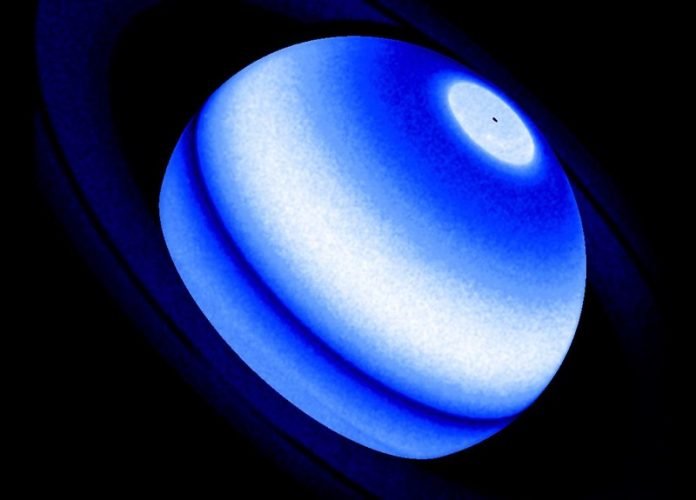
Saturn’s rings are one of the most well-known features throughout astronomy.
While much is known about them, they still make headlines from time to time.
This includes a recent study involving an international team of researchers that could help paint a clearer picture of the interaction between the gas giant and the massive ring system that encircles it.
For the study, the researchers used a combination of data gathered between 1980 and 2017 from both active and retired space missions to examine ultraviolet (UV) observations of atomic hydrogen emissions within the upper atmosphere of Saturn that appear as a spectral line of hot hydrogen.
What they discovered was a first-of-its-kind view of Saturn and indications that its massive ring system is responsible for heating the gas giant’s atmosphere.
In this case, icy particles from the rings rain down from a combination of Saturn’s immense gravity and other possibilities, including solar ultraviolet radiation, micrometeorite impacts, electromagnetic forces, and bombardment from the solar wind. In fact, NASA’s Cassini confirmed the raining of particles from the rings during its atmospheric plunge into Saturn, also known as the “Grand Finale”, in 2017.
“Though the slow disintegration of the rings is well known, its influence on the atomic hydrogen of the planet is a surprise.
From the Cassini probe, we already knew about the rings’ influence. However, we knew nothing about the atomic hydrogen content,” said Dr. Lotfi Ben-Jaffel of the Institute of Astrophysics in Paris and the Lunar & Planetary Laboratory at the University of Arizona, and lead author of the study.
“Everything is driven by ring particles cascading into the atmosphere at specific latitudes. They modify the upper atmosphere, changing the composition. And then you also have collisional processes with atmospheric gases that are probably heating the atmosphere at a specific altitude.”
The ring disintegration on Saturn that Dr. Ben-Jaffel mentions likely comes from a 2018 study that confirmed Saturn could lose all its rings within the next 100 million years, which builds off previous observations from NASA’s Voyager 1 and 2.
The space missions that contributed the UV data used for this study came from NASA’s Hubble Space Telescope, NASA’s retired Cassini spacecraft, the European Space Agency’s retired International Ultraviolet Explorer mission, and NASA’s Voyager 1 and 2 spacecraft when they flew through the Saturn system in 1980 and 1981, respectively.
This means the researchers used data from between 1980 and 2017, with scientists initially overlooking data exhibiting atmospheric UV surplus measured by Voyager 1 and 2, having interpreted it as noise, and with similar data being gathered by all the missions over the next 37 years.
The longstanding conundrum was trying to determine whether all this data from five space missions over the course of almost 40 years was accurate or deceptive, but Dr. Ben-Jaffel stepped up to the task and decided to use Hubble’s Space Telescope Imaging Spectrograph (STIS) to collect UV data from Saturn in 2017 and calibrate it against all the data back to 1980.
“When everything was calibrated, we saw clearly that the spectra are consistent across all the missions. This was possible because we have the same reference point, from Hubble, on the rate of transfer of energy from the atmosphere as measured over decades,” said Dr. Ben-Jaffel.
“It was really a surprise for me. I just plotted the different light distribution data together, and then I realized, wow – it’s the same.”
In the end, Dr. Ben-Jaffel found the same level of UV radiation from all the data between all the space missions. This finding was assisted by examining our Sun’s seasonal effects on Saturn from the various solar cycles over the almost 40 years of data, as well.
“At any time, at any position on the planet, we can follow the UV level of radiation,” said Dr. Ben-Jaffel. “This points to the steady ‘ice rain’ from Saturn’s rings as the best explanation.
We are just at the beginning of this ring characterization effect on the upper atmosphere of a planet. We eventually want to have a global approach that would yield a real signature about the atmospheres on distant worlds.
One of the goals of this study is to see how we can apply it to planets orbiting other stars. Call it the search for ‘exo-rings.’”
What new discoveries will scientists make about Saturn’s rings in the coming years and decades, and could this be used to hunt for “exo-rings”? Only time will tell, and this is why we science!
As always, keep doing science & keep looking up!
Written by Laurence Tognetti.
Source: Universe Today.



